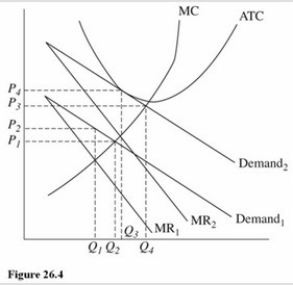A) Monopoly.
B) Duopoly.
C) Monopolistic competition.
D) Oligopoly.
Correct Answer

verified
Correct Answer
verified
True/False
The combined market share for the top four firms in a monopolistically competitive industry will typically be in the range of 20 to 40 percent.
Correct Answer

verified
Correct Answer
verified
Multiple Choice
 Refer to Figure 26.4 for a monopolistically competitive firm.If the firm currently faces Demand1 and MR1,then it will earn
Refer to Figure 26.4 for a monopolistically competitive firm.If the firm currently faces Demand1 and MR1,then it will earn
A) A positive economic profit,and firms will enter the industry.
B) A negative economic profit,and firms will enter the industry.
C) A negative economic profit,and firms will exit the industry.
D) Zero economic profit,and neither entry nor exit will occur.
Correct Answer

verified
Correct Answer
verified
True/False
A successful advertising campaign alters the demand curve and the supply curve facing the firm.
Correct Answer

verified
Correct Answer
verified
Multiple Choice
The kinked oligopoly demand curve does not describe the demand curve for monopolistic competition because in monopolistically competitive markets,
A) Firms are not as interdependent as oligopolistic firms.
B) Firms have no market power.
C) There is not as much product differentiation as in oligopoly.
D) There is no nonprice competition.
Correct Answer

verified
Correct Answer
verified
Multiple Choice
For which of the following market structures will the firm's demand curve be tangent to the ATC curve in the long run?
A) Duopoly.
B) Monopolistic competition.
C) Oligopoly.
D) Monopoly.
Correct Answer

verified
Correct Answer
verified
True/False
Firms in a monopolistically competitive market make independent production decisions.
Correct Answer

verified
Correct Answer
verified
Multiple Choice
In monopolistic competition there is allocative inefficiency because
A) Price is greater than the minimum ATC.
B) Production is not at the minimum ATC.
C) Of excess capacity.
D) Price is greater than MC.
Correct Answer

verified
Correct Answer
verified
True/False
As new firms enter a monopolistically competitive industry,the demand curve for an individual firm shifts to the right.
Correct Answer

verified
Correct Answer
verified
Multiple Choice
Brand loyalty
A) Makes the demand curve facing the firm more price-elastic.
B) Leads to one price for all brands.
C) Exists even when products are virtually identical.
D) Is possible only when there are a few firms in the market.
Correct Answer

verified
Correct Answer
verified
Multiple Choice
Demand and Cost Data for Sylvie's Shampoo Company Table 26.2 A Monopolistically Competitive Firm Refer to Table 26.2.To maximize profit,Sylvie's Shampoo Company.should produce ________ bottles of shampoo and charge a price of ________ each.
A) 6;$22
B) 7;$20
C) 8;$18
D) 9;$16
Correct Answer

verified
Correct Answer
verified
Multiple Choice
A concentration ratio measures the
A) Proportion of industry output produced by all firms.
B) Proportion of total industry output produced by the largest firms.
C) Dollar value of total industry output produced by all firms.
D) Dollar value of total industry output produced by the largest firms.
Correct Answer

verified
Correct Answer
verified
Multiple Choice
Monopolistic competition results in allocative
A) Inefficiency and productive efficiency.
B) Inefficiency and productive inefficiency.
C) Efficiency and productive efficiency.
D) Efficiency and productive inefficiency.
Correct Answer

verified
Correct Answer
verified
Multiple Choice
A major difference between oligopoly and monopolistic competition is that oligopolies do not
A) Have high concentration ratios.
B) Have many competitors.
C) Have high barriers to entry.
D) Confront a downward-sloping demand curve.
Correct Answer

verified
Correct Answer
verified
True/False
In monopolistically competitive markets,product differentiation is a significant barrier to entry.
Correct Answer

verified
Correct Answer
verified
Multiple Choice
An In the News article titled "Selling "Pure Water": A $Billion Scam?" refers to the use of advertising.When a firm successfully advertises its product,the firm
A) Has more control over its price.
B) Has less control over its price.
C) Still has no control over its price because all firms are price takers.
D) Has total control over its price.
Correct Answer

verified
Correct Answer
verified
Multiple Choice
An In the News article titled "Selling "Pure Water": A $Billion Scam?" refers to the use of advertising.When a firm successfully advertises its product,the price elasticity of demand becomes
A) More elastic.
B) Less elastic.
C) More efficient.
D) Less efficient.
Correct Answer

verified
Correct Answer
verified
Multiple Choice
Demand and Cost Data for Will's Beach Ball Company Table 26.1 A Monopolistically Competitive Firm Refer to Table 26.1.At the profit-maximizing output and price,Will's Beach Ball Company will earn a ________ economic profit,and ________ the market will occur.
A) negative;exit from
B) negative;entry into
C) positive;exit from
D) positive;entry into
Correct Answer

verified
Correct Answer
verified
Multiple Choice
Demand and Cost Data for Sylvie's Shampoo Company Table 26.2 A Monopolistically Competitive Firm Refer to Table 26.2.At the profit-maximizing output and price,Sylvie's Shampoo Company will earn a profit equal to
A) $36.
B) $30.
C) $140.
D) $144.
Correct Answer

verified
Correct Answer
verified
Multiple Choice
All of the following are examples of nonprice competition except
A) Differentiation of service.
B) Advertising.
C) Quality differences.
D) Zero economic profit.
Correct Answer

verified
Correct Answer
verified
Showing 61 - 80 of 144
Related Exams